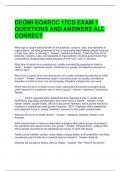DEOMI EOARCC 17CD EXAM 1
QUESTIONS AND ANSWERS ALL
CORRECT
What type of racism takes the form of the practices, customs, rules, and standards of
organizations, including governments that unnecessarily disadvantage people because
of their race, color, or ethnicity? - Answer- Institutional Racism: Takes the form of the
practices, customs, rules, and standards of organizations, including governments that
unnecessarily disadvantage people because of their race, color, or ethnicity.
What form of racism is a conscious act, usually motivated by prejudice or intent to
harm? - Answer- Intentional racism: conscious act, usually motivated by prejudice or
intent to harm
What form of racism is an unconscious act, not usually motivated by prejudice or intent
to harm? - Answer- Unintentional racism: unconscious act not usually motivated by
prejudice or intent to harm. It is still damaging. Prejudice underlies the end result.
Which type and form of racism occurs when organizational policies knowingly cause
unfair treatment to a particular race or ethnic group? - Answer- Intentional, Institutional
Racism
_______ racism originates within established and respected forces in society and
receives far less public condemnation than other forms of racism. - Answer- Covert
racism: hidden, usually subtle, difficult to document treatment, which proves harmful to
members of subordinate racial groups (Scarville, 1997). Originates within established
and respected forces in society, therefore, receives far less public condemnation
What are the forms of subtle racism? - Answer- Traditional, Symbolic, Modern, and
Aversive.
What internal factor of racism is described as judging other ethnic groups according to
the standards and values of one's own group? - Answer- Ethnocentrism - judging other
ethnic groups according to the standards and values of one's own group.
Family, social visibility, contact, mass media, unequal power, and competition: are these
considered a part of internal or external factors of racism? - Answer- External
Describe the concept of Reject, Recruit, Reject. - Answer- The "Three R Syndrome"
, a. Reject - Minorities were not allowed to enlist in the armed services at the onset of
periods of hostilities.
b. Recruit - When the need for military personnel increased because of manpower
demands and insufficient numbers, minorities were recruited, usually during a conflict
and after enormous casualties. After induction, most minorities were segregated, poorly
trained, and/or relegated to low levels or hazardous jobs.
c. Reject: When hostilities were over, the units were disbanded and the racial minorities
were released from any requirements to serve, despite any desire to continue service.
In some cases, minorities were denied veterans' benefits.
What term describes the practice of placing men into military units based upon the color
of their skin? - Answer- segregation
Regarding strategies to combat racism in the military, what is the difference between
awareness programs and education programs? - Answer- a. Awareness - Groups are
aware and are making others aware of the existence of individual and institutional
racism in its contemporary and subtle forms. Within the unit, celebrations such as
National American Indian Heritage Month and Black History Month help promote
awareness of the contributions these groups have made to the military and the United
States.
b. Education - Awareness is facilitated through education. Courses, small group
discussions, workshops, guest speakers, and movies provide educational opportunities
for the unit. Topics related to racism can be addressed, including how racism
dehumanizes people, the tremendous financial costs of racism, and contemporary
racism.
What are the two types of teaching lectures? - Answer- Formal and Informal
Limited student participation; can't be used to teach skills; and difficulty in evaluating
learning describe: - Answer- Disadvantages of a Teaching Lecture
What is the definition of a guided discussion? - Answer- Instructor controlled group
process in which students share information and experiences to achieve a learning
objective.
What are four advantages of a guided discussion? - Answer- 1) Allows everyone to
participate in the learning situation
2) Pools knowledge and experience of all participants
3) Stimulates and motivates participants when well organized




